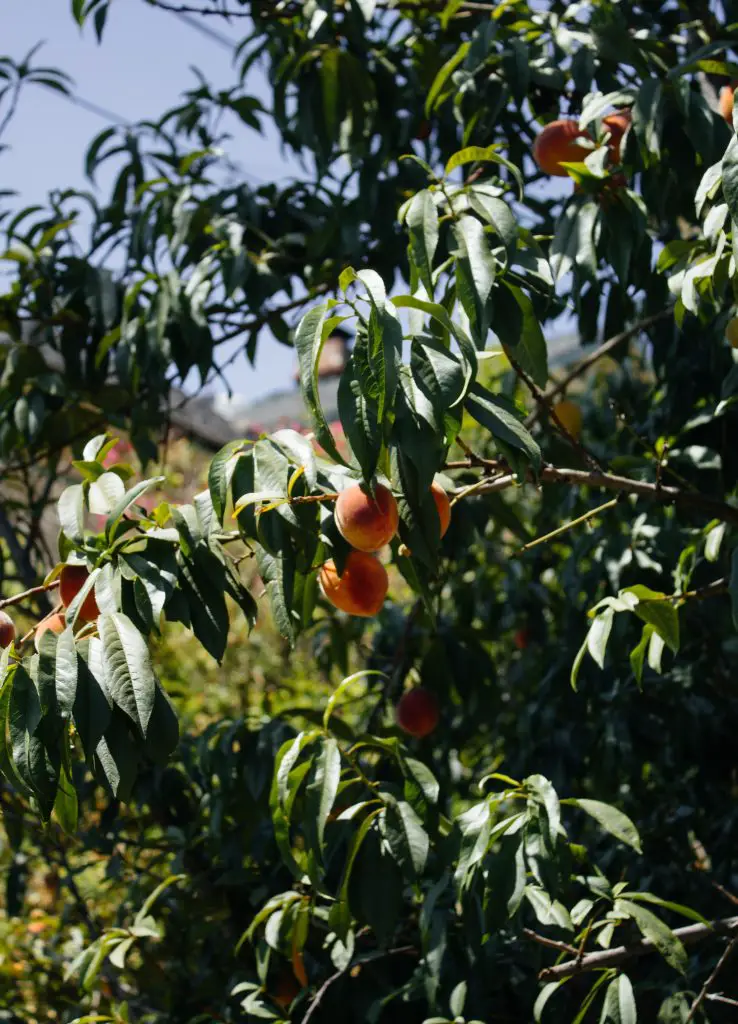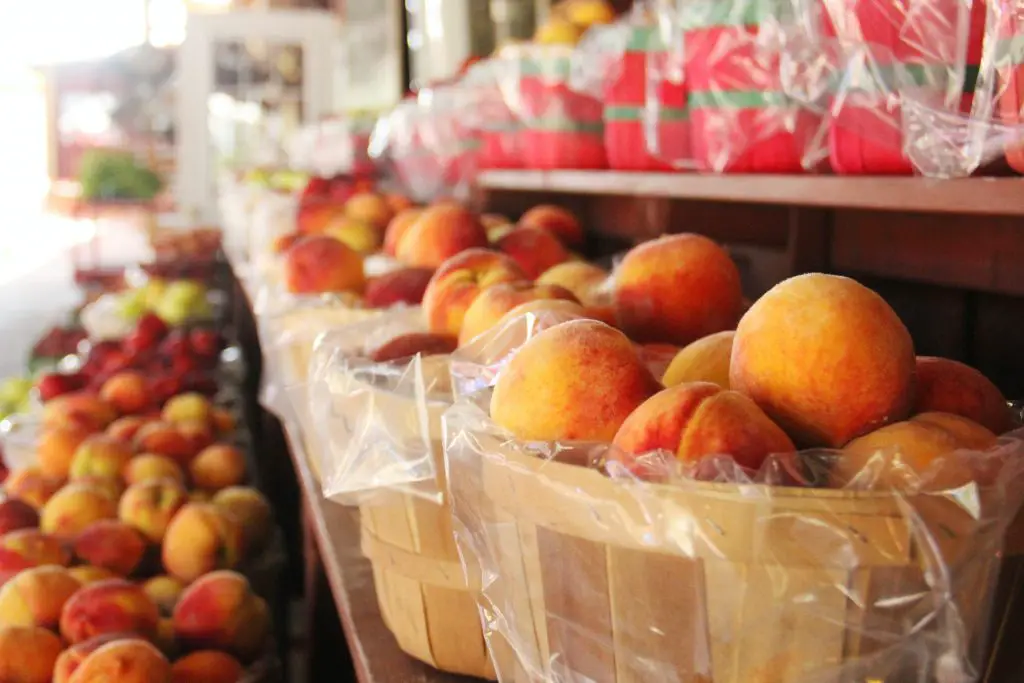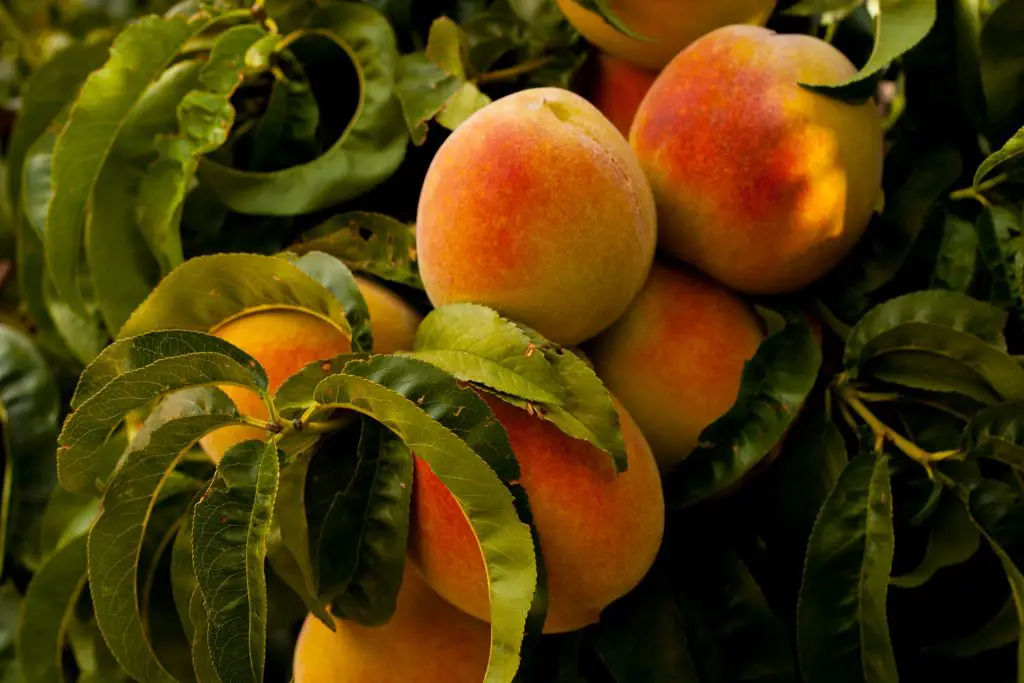How Many peaches Does A Tree Produce? Juicy Peaches are a fantastic treat when eaten directly from the tree at the height of summer. They are also suitable for canning as a treat for the cold winter months when there is no fresh fruit available.
A mature peach tree will typically yield between 44 and 66 lbs (20 and 30 kg) per season according to a study by the University of Egypt. This equates to approximately 250 to 270 peaches per year. However, if you do not have space for a full-sized peach tree there are Dwarf varieties available that will produce around 22 to 33 lbs (10 to 15 kgs) of fruit when they reach maturity.
Peach trees will typically take 2 years before they begin to fruit if you purchase a tree from the local garden center. The trees that are sold at retail outlets are usually grafted trees that are one year old. The fruiting spurs on the tree usually need to be one to two years old before they produce fruit. If you are growing a peach tree from seed it usually takes three to four years for the tree to produce fruit.
What Is A Suitable Climate To Grow A Peach Tree?
Peach trees are suitable for growing in zones 5 to 10 and are able to tolerate temperatures down to -25°F (-31°C). However, at these temperatures fruit buds and new growth will be destroyed, the buds of most varieties can only tolerate -15°F (-26°C.).

However, the suitability of Peach varieties for different climates is dependent upon the number of chill hours the variety requires. Chill hours is the length of time that a Peach Tree needs to be exposed to temperatures below 45°F (7°C). If the tree does not receive a sufficient period of cold it will not fruit.
To approximate the number of chill hours in your climate take the average temperature in your coldest month and compare it to the table provided below.
Chill Hours Average Temperature For Coldest Month
0 19.7°C (67.5°F) – No Chill
300 15.5°C (59.9°F) – Low Chill
330 15.3°C (59.5°F) – Low Chill
450 14.0°C (57.2°F) – Medium Chill
500 13.6°C (56.5°F) – Medium Chill
520 13.1°C (55.6°F) – Medium Chill
600 12.7°C (54.9°F) – Medium to High Chill
800 10.2°C (50.4°F) – High Chill
1100 7.9°C (46.2°F) – High Chill
1250 0.0°C (32.0°F) – Very High Chill
Once you have estimated the number of chill hours in your location compare it with the table below which contains a selection of common varieties and the chill hours required.
| Chill Hours | Variety |
| 200 – 350 Hrs | UF Gold, UF2000, Floridacrest, Florida Dawn |
| 650 – 800 Hrs | Goldcrest, Goldprince, Bicentennial, Caroline Belle , Fairtime, Fay Elberta, Finale, Flavorcrest, Loring, Sunbrite, Sunhigh, Sunland, Sunprince, Topaz, |
| 850 – 1050 Hrs | Belle of Georgia, Elberta, Ellerbe, Fayette, Halehaven, Hamlet, Harbelle, Jerseyglo, Jerseyland, Jerseyqueen, J.H. Hale, Majestic, Redglobe, Sentry, Shippers Late Red, Encore, Newhaven, Redhaven, Troy, Tyler, Velvet, Washington, Reliance, Surecrop, Contender, |
Do Peach Trees Need More Than One Tree To Fruit?
The vast majority of Peach trees are self-fertile, which means that planting one tree is all that’s needed for fruit production. However, many fruit trees benefit from having a second tree as improves the degree of cross-pollination in many cases.
In the case of Peaches, they can be cross-pollinated by both Peach and Nectarine trees. The reason for this is that they are actually the same species of plant, the key defining feature is that the Peaches have fuzz on the surface whereas Nectarines do not.
For those that have not looked at a high school textbook recently plants are considered the same species if they are able to interbreed and produce offspring that themselves can also breed.
Peach and Nectarine are sufficiently similar for this to occur which is advantageous for a home gardener as it provides the opportunity to expand the number of fruit trees in the yard while improving the output of the existing ones. To read more about Nectarines click here.

How to Plant a Peach Tree
Once you have selected the variety of Peach tree that you want to have in your garden plant it in late winter or early spring. This is the best time because Peach trees can be purchased as bare-rooted plants which are much cheaper than potted plants. Additionally, it allows time for the newly planted tree’s root system to develop and adjust to the local environment for an entire growing season before the winter arrives.
Once the tree has been selected the next important step is to select a planting location. Ideally, Peach trees should be planted in a location that gets at least 8 hours of sun per day. Additionally, they prefer a shielded location as high winds can affect the rate of pollination.
In terms of soil conditions Peach trees generally don’t like wet feet, as such a well-drained soil that is rich with plenty of organic matter that is slightly acidic is preferred. A pH between 6 and 7 is ideal, to measure this it is best to use a pH meter rather than a pH kit with strips. Meters are easier to use and cheaper, click here to see the latest price on Amazon.
Once the soil has been prepared dig a hole approximately 1 to 2 ft (30 cm to 60cm) deep and hammer a stake into the ground in the planting hole. Position the tree in the hole ensuring that it is planted at a depth approximately equal to the level the tree had previously been in the ground.
Backfill the hole with soil, to ensuring that there are no air pockets around the root-ball firm the soil down with your heel. Once the hole is filled with soil water the tree in well and cover the surrounding soil with a thick layer of organic mulch, 2 to 4 inches is ideal.
Prune the tree by trimming branches to a height of 1 to 2 ft (30 to 60 cm) above where the branches fork. This should be done ideally just above an outward-facing bud. This type of pruning may seem a little drastic, however, Peach trees grow extremely quickly. The cuts will encourage the tree to produces lots of new wood. Over time this will lead to an increase in fruit production.

Once the tree has been pruned attach the tree trunk to the stake using tree ties. The ties should be made of soft flexible material to ensure the tree branches have the ability to expand in width over time.
How to Care for a Peach Tree
To care for a tree once it is planted it is important, particularly in the first season, to ensure that the soil remains moist. We recommend giving new trees around 2 gallons (8 litres) of water per week in the first season.
In addition to watering, trees should be fertilized in early spring with a slow-release fertilizer. This will ensure that there are adequate nutrients throughout the growing season. When choosing a fertilizer select one that is high in phosphorus and low in nitrogen to encourage fruit formation.
In addition to fertilizing, trees will need to be pruned on an annual basis to maximize the production of fruit. The aim of pruning should be to maintain a vase-like shape. To achieve this remove any inward-facing branches to ensure that the light and air are able to enter the structure of the tree easily. Reduce the height of the outward-facing branches to ensure that you are able to reach the fruit from the ground easily.
How to Harvest Peaches
Peaches will ripen in the latter stages of summer in most regions. To ensure that you get the best possible flavor it’s important that they are harvested at the right time. The best indicator of ripeness will be a color change. Peaches will ripen to a yellow and red color depending on the variety.
The other key indicator of ripeness is the Peach will begin to soften, to test this gently press on the Peach, if it is ready there will be a small amount of give in the fruit. Lastly, you can pick a fruit and taste it before harvesting the rest of your crop to make 100% sure it is ripe.
